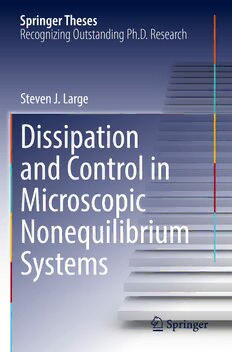Table Of ContentSpringer Theses
Recognizing Outstanding Ph.D. Research
Steven J. Large
Dissipation
and Control in
Microscopic
Nonequilibrium
Systems
Springer Theses
Recognizing Outstanding Ph.D. Research
AimsandScope
The series “Springer Theses” brings together a selection of the very best Ph.D.
theses from around the world and across the physical sciences. Nominated and
endorsed by two recognized specialists, each published volume has been selected
for its scientific excellence and the high impact of its contents for the pertinent
fieldofresearch.Forgreateraccessibilitytonon-specialists,thepublishedversions
includeanextendedintroduction,aswellasaforewordbythestudent’ssupervisor
explainingthespecialrelevanceoftheworkforthefield.Asawhole,theserieswill
provideavaluableresourcebothfornewcomerstotheresearchfieldsdescribed,and
for other scientists seeking detailed background information on special questions.
Finally,itprovidesanaccrediteddocumentationofthevaluablecontributionsmade
bytoday’syoungergenerationofscientists.
Thesesmaybenominatedforpublicationinthisseriesbyheadsofdepartment
at internationally leading universities or institutes and should fulfill all of the
followingcriteria
(cid:129) TheymustbewritteningoodEnglish.
(cid:129) ThetopicshouldfallwithintheconfinesofChemistry,Physics,EarthSciences,
EngineeringandrelatedinterdisciplinaryfieldssuchasMaterials,Nanoscience,
ChemicalEngineering,ComplexSystemsandBiophysics.
(cid:129) Theworkreportedinthethesismustrepresentasignificantscientificadvance.
(cid:129) If the thesis includes previously published material, permission to reproduce
this must be gained from the respective copyright holder (a maximum 30%
of the thesis should be a verbatim reproduction from the author’s previous
publications).
(cid:129) They must have been examined and passed during the 12 months prior to
nomination.
(cid:129) Eachthesisshouldincludeaforewordbythesupervisoroutliningthesignificance
ofitscontent.
(cid:129) The theses should have a clearly defined structure including an introduction
accessibletonewPhDstudentsandscientistsnotexpertintherelevantfield.
IndexedbyzbMATH.
Moreinformationaboutthisseriesathttp://www.springer.com/series/8790
Steven J. Large
Dissipation and Control in
Microscopic Nonequilibrium
Systems
Doctoral Thesis accepted by Simon Fraser University, BC,
Canada
StevenJ.Large
ViewpointInvestmentPartners
Calgary,AB,Canada
ISSN2190-5053 ISSN2190-5061 (electronic)
SpringerTheses
ISBN978-3-030-85824-7 ISBN978-3-030-85825-4 (eBook)
https://doi.org/10.1007/978-3-030-85825-4
©TheEditor(s)(ifapplicable)andTheAuthor(s),underexclusivelicensetoSpringerNatureSwitzerland
AG2021
Thisworkissubjecttocopyright.AllrightsaresolelyandexclusivelylicensedbythePublisher,whether
thewholeorpartofthematerialisconcerned,specificallytherightsoftranslation,reprinting,reuse
ofillustrations,recitation,broadcasting,reproductiononmicrofilmsorinanyotherphysicalway,and
transmissionorinformationstorageandretrieval,electronicadaptation,computersoftware,orbysimilar
ordissimilarmethodologynowknownorhereafterdeveloped.
Theuseofgeneraldescriptivenames,registerednames,trademarks,servicemarks,etc.inthispublication
doesnotimply,evenintheabsenceofaspecificstatement,thatsuchnamesareexemptfromtherelevant
protectivelawsandregulationsandthereforefreeforgeneraluse.
Thepublisher,theauthors,andtheeditorsaresafetoassumethattheadviceandinformationinthisbook
arebelievedtobetrueandaccurateatthedateofpublication.Neitherthepublishernortheauthorsor
theeditorsgiveawarranty,expressedorimplied,withrespecttothematerialcontainedhereinorforany
errorsoromissionsthatmayhavebeenmade.Thepublisherremainsneutralwithregardtojurisdictional
claimsinpublishedmapsandinstitutionalaffiliations.
ThisSpringerimprintispublishedbytheregisteredcompanySpringerNatureSwitzerlandAG
Theregisteredcompanyaddressis:Gewerbestrasse11,6330Cham,Switzerland
–Tothememoryof ThomasGeorgeSmith
Supervisor’s Foreword
Encompassing several independent research thrusts, Dr. Steven Large’s thesis
tackles a wide range of important open questions in nonequilibrium statistical
mechanics,asubfieldofphysicsthatpromisesinsightsintothedesignprinciplesof
molecular-scale biological systems. Steve’s thesis work establishes a multifaceted
extension of the deterministic control framework that has been the workhorse
of the field for the past 20 years to systems that are strongly fluctuating and
autonomous,therebyfacilitatingtheapplicationofstochasticthermodynamicsideas
to understand molecular machines in nanotechnology and in living things. This
thesiscontainsseveraldistincttypesofcontributions:purelytheoreticalderivations,
numerical simulations to systematically characterize model systems, experimental
design,andanalysisofexperimentaldata.
In his examination of the control of strongly fluctuating microscopic systems,
Steve derived simple, tractable, and surprisingly general conclusions (that upon
reflection are intuitive). He subsequently generalized this work to autonomous
settings, establishing connections to the chemical kinetics literature. As part of
this project, Steve uncovered a conceptual blind spot in recent stochastic ther-
modynamics research, establishing the rigorous generalization of fundamental
thermodynamicsconceptstoautonomouscomplexsystems.
On the applied side, Steve put these theoretical developments to work by
designing, analyzing, and interpreting the first experimental demonstration (by
collaboratorsSaraTafoyaandCarlosBustamante,UCBerkeley)oftheutilityofthis
generallyapplicablemethod(thatsomenaturallyevolvedmachinesshowevidence
ofusing)fordesigningenergeticallyefficientcontrolinbiomolecules:driveslowly
wherefrictionislargeandrapidlywherefrictionissmall.Heanalyzedrawdatafrom
equilibrium single-molecule experiments on small DNA molecules and designed
subsequent nonequilibrium experiments demonstrating that protocols optimized
using this framework systematically and statistically significantly reduced energy
loss compared to naive protocols, across a wide range of experimental unfolding
speedsandwildlydifferentDNAmolecules.
Taken as a whole, these theoretical advances and experimental demonstrations
give a scale on which to evaluate the energetic efficiency of molecular machines,
vii
viii Supervisor’sForeword
guidelines for designing effective synthetic machines, and a perspective on the
engineering principles that govern effective microscopic energy transmission far
fromequilibrium.
Burnaby,Canada Prof.DavidA.Sivak
June2021
Acknowledgment
Firstandforemost,IwouldliketothankmysupervisorDavidSivakforhissupport
and guidance over the past 5 years. You granted me independence to follow my
interests and immerse myself in the truest essence of academic research. The
experience I have gained by working with you has been essential in strengthening
mycapabilities,andhasbeenvitaltomycontinueddevelopmentasascientist.
ThroughoutmygraduateeducationIhavehadthegreatopportunityofworking
closelywithanumberofcollaborators,fromwhomIhavebenefitedgreatly.Iwould
liketothankCarlosBustamante,ShixinLiu,andparticularlySaraTafoyafortheir
patienceandperseveranceworkingontheDNAhairpinproject.Iwouldalsoliketo
thankRaphaëlChetriteandJannikEhrichfortheircollaborationonvariousprojects
throughoutthepastfewyears,Igreatlyenjoyedworkingwithyouboth.
I would also like to thank the guidance of my supervisory committee, John
Bechhoefer and Eldon Emberly. Your unique approaches to scientific problems
and continued feedback through the years has helped to broaden the scope of my
thinking. The content of this thesis has been improved and clarified significantly
fromyourencouragementandsuggestions.
IgreatlyappreciatethefinancialsupportIhavereceivedthroughoutmygraduate
studies, including NSERC CGS-M and CGS-D3 fellowships, as well as the Billy
Jones and Howard Malm graduate awards in physics, made possible through the
continuedgenerosityofSFUdonors.
I would also like to thank my parents, Andrew and Sandra, for believing in me
through the past 5 years and beyond. Ever since I left to start my undergraduate
degree in 2011 at the University of Guelph, I could always depend on your
encouragementandunwaveringsupport.IalsowouldliketothankmysisterJenny,
herhusbandIan,andsonNate,foralwaysbeingthereforme.
Throughtheupsanddownsofgraduateschool,friendsandcolleaguesmakethe
worst of times better and the best of times great. I would like to acknowledge the
entire cast of Sivak group members over the past 5 years, with a special mention
of Aidan Brown and Alexandra Kasper, who helped immensely in the early years
of grad school. I also benefited greatly from many colleagues and friends in the
broader physics graduate student body, with a particular thanks owing to Chapin
ix
x Acknowledgment
Korosec, Konstantin Lehmann, and Benny Jäger. I also want to thank the friends
whohavebeenalongforthewholeride,JordanElvedahlandScottMatthews,such
lastingfriendshipsburnamarkonusall,yourroleinkeepingmetetheredtoreality
throughthelastdecadecannotbeunderstated.
Finally, I would like to thank my future wife Maegan Kelleway. Your support
andencouragementthroughoutgraduateschoolhavebeenindispensable,ultimately,
you—above all others—have helped me keep a clear head through this whole
process. The past 5 years especially have brought many changes to our life, and
thisworkwouldn’thavebeenpossiblewithoutyou.Thisclosesonechapteronour
lifeandbeginsanother,onedayatatime.

